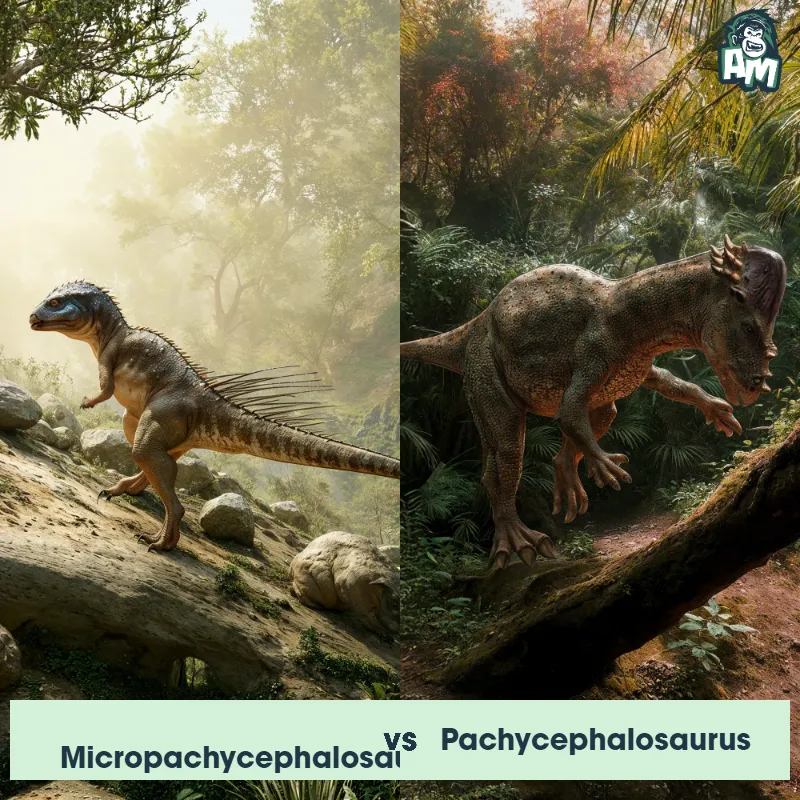The Micropachycephalosaurus
The Micropachycephalosaurus, also known as the "Tiny Thick-Skulled Lizard," is a small dinosaur characterized by its dome-shaped skull and short, stocky body. It had a relatively large brain for its size, indicating a degree of intelligence. This herbivorous dinosaur likely walked on two legs and had a beak-like snout for feeding on plants.

| Micropachycephalosaurus | |
|---|---|
| Size | 3 feet (0.9 meters) |
| Weight | 10 pounds (4.5 kilograms) |
| Speed | 15mph (24km/h) |
| Key Strength | Speed |
| Biggest Weakness | Small size |
| Scientific Name | Micropachycephalosaurus |
| Family | Pachycephalosauridae |
| Habitat | Land |
| Geography | Asia |
| Diet | Herbivore |
| Lifespan | 5 years - 7 years |

The Micropachycephalosaurus
The Micropachycephalosaurus, also known as the "Tiny Thick-Skulled Lizard," is a small dinosaur characterized by its dome-shaped skull and short, stocky body. It had a relatively large brain for its size, indicating a degree of intelligence. This herbivorous dinosaur likely walked on two legs and had a beak-like snout for feeding on plants.
Fun Fact: Micropachycephalosaurus is believed to have used its thick, bony skull for head-butting during mating rituals or establishing dominance within its herd.
| Micropachycephalosaurus | |
|---|---|
| Size | 3 feet (0.9 meters) |
| Weight | 10 pounds (4.5 kilograms) |
| Speed | 15mph (24km/h) |
| Key Strength | Speed |
| Biggest Weakness | Small size |
| Scientific Name | Micropachycephalosaurus |
| Family | Pachycephalosauridae |
| Habitat | Land |
| Geography | Asia |
| Diet | Herbivore |
| Lifespan | 5 years - 7 years |
Micropachycephalosaurus Matchups
We use AI to simulate matchups between the Micropachycephalosaurus and other animals. Our simulation considers size, strength, and natural predatory behaviors to determine the most likely outcome.

Can't find the Matchup you want?
Create Your Own MatchupMicropachycephalosaurus: Diet, Predators, Aggression, and Defensive Behaviors
What did Micropachycephalosaurus eat?
Micropachycephalosaurus were herbivores, meaning they primarily fed on plants such as ferns, cycads, and other vegetation during the Late Cretaceous period. Their diet consisted mainly of low-growing plants and shrubs that were abundant in their environment.
Did Micropachycephalosaurus have any predators?
As relatively small herbivorous dinosaurs, Micropachycephalosaurus may have been preyed upon by larger predators of their time, such as theropod dinosaurs like Tarbosaurus or Alioramus. These predators could have posed a threat to Micropachycephalosaurus, especially younger individuals or those that were isolated from their herd.
Were Micropachycephalosaurus aggressive?
Micropachycephalosaurus is believed to have been relatively small and likely not aggressive towards other dinosaurs or individuals of their own species. They may have exhibited some territorial behaviors or aggression during mating seasons, but they were not known for being particularly aggressive compared to other dinosaur species.
Did Micropachycephalosaurus fight?
Micropachycephalosaurus most likely did not engage in physical fights with other dinosaurs, as they were small and lacked the physical adaptations for combat. Instead, they may have used their agility, camouflage, or group dynamics to avoid conflicts and protect themselves from potential threats.
How did Micropachycephalosaurus defend themselves?
Micropachycephalosaurus may have used their small size, speed, and agility to evade predators or potential threats. They might have also relied on their natural camouflage to blend in with their surroundings and avoid detection. Additionally, they may have lived in herds for protection, as there is safety in numbers when facing predators.
What was Micropachycephalosaurus's biggest weakness in a fight?
Due to their small size and lack of physical weaponry, Micropachycephalosaurus's biggest weakness in a fight would likely be their inability to physically defend themselves against larger, more powerful predators. Their best defense would be to rely on their speed, agility, and group behavior to evade and outmaneuver potential threats.
Fun Fact: Despite its name, Micropachycephalosaurus was not closely related to the more famous Pachycephalosaurus and belonged to a distinct group of dinosaurs known as pachycephalosaurids.
Fun Fact: Fossil remains of Micropachycephalosaurus have been found in China, where this dinosaur roamed during the Late Cretaceous period alongside other unique creatures of the time.











